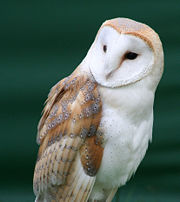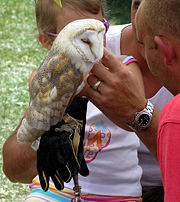Barn Owl
2008/9 Schools Wikipedia Selection. Related subjects: Birds
- The place in Russia is spelled Barnaul.
| Barn Owl | ||||||||||||||
|---|---|---|---|---|---|---|---|---|---|---|---|---|---|---|
 |
||||||||||||||
| Conservation status | ||||||||||||||
|
Least Concern
|
||||||||||||||
| Scientific classification | ||||||||||||||
|
||||||||||||||
| Binomial name | ||||||||||||||
| Tyto alba ( Scopoli, 1769) |
||||||||||||||
 Global distribution of Tyto alba
|
||||||||||||||
| Synonyms | ||||||||||||||
|
Lechusa stirtoni Miller, 1956 |
The Barn Owl (Tyto alba) is the most widely distributed species of owl, and one of the most widespread of all birds. It is also referred to as Common Barn Owl, to distinguish it from other species in the barn owl family Tytonidae, any one of which may be called a barn owl. Tytonidae is one of the two groups of owls, the other being the typical owls Strigidae.
Description
The Barn Owl is a pale, long-winged, long-legged owl with a squarish tail. Tail shape is a way of distinguishing the Barn Owl from owls of the [ ] family. 33–39 cm in length with an 80–95 cm wingspan. Its head and upperparts are buff, and the underparts are white. The face is heart-shaped.
In the US it is incorrectly sometimes called Screech Owl because the Barn Owl has a notable shree scream, ear-shattering at close range. It can hiss like a snake, and when captured or cornered, it throws itself on its back and flails with sharp-taloned feet, an effective defence. Contrary to popular belief, it does not make the call "tu-whit to-whoo" (which is made by the Tawny Owl).
Distribution and habitat
The Barn Owl is one of the most widespread vertebrate species on Earth, occurring on every continent except Antarctica. It is absent from most of Canada and Alaska, as well as Greenland, most of central and eastern Asia, the Sahara Desert, New Zealand, and some Pacific islands. It is a bird of open country, such as farmland, preferring to hunt along the edges of woods.
Food and hunting
The Barn Owl feeds primarily on small vertebrates, particularly rodents, but also small bats, birds and reptiles. It also sometimes eats insects. Studies have shown that an individual Barn Owl may eat one or more rodents per night; a nesting pair and their young can eat more than 1000 rodents per year.
It has an effortless wavering flight as it quarters pastures or similar hunting grounds. Alternative names often refer to the appearance, white underparts, or eerie, silent flight, including Monkey-faced Owl, Ghost Owl, Church Owl, Golden Owl, Rat Owl and Stone Owl. Like most owls, the Barn Owl flies silently; tiny serrations on the leading edges of its flight feathers help to break up the flow of air over its wings, thereby reducing turbulence—and the noise that accompanies it. They hunt by flying low and slowly over an area of open ground, hovering over spots that conceal potential prey.
Its ears are placed asymmetrically for maximum hearing, so the owls do not require sight to hunt. They can target and dive down to sink their talons through snow, grass or brush and seize rodents with deadly accuracy. Compared to other owls of similar size, the Barn Owl has a much higher metabolic rate, requiring relatively more food. Pound for pound, they consume more rodent pests than possibly any other creature. This makes the Barn Owl one of the most economically valuable wildlife animals to farmers. Farmers find these owls more effective than poisons, and they often encourage Barn Owls to stay around by providing nest sites. They are nocturnal or crepuscular.
Threats
Predators of the Barn Owl include opossums, raccoons, certain snakes, and other raptors such as hawks, eagles, and larger owls (including the Great Horned Owl and the Eurasian Eagle Owl). The most common threats come from humans and their pets. A house cat can kill an owl with a single bite if the injury is not treated right away.
Status
Barn Owls are relatively common throughout most of their range but they are rare in Britain. The most recent survey of their numbers in the UK put their population at around 4400 breeding pairs. In the US, Barn Owls are listed as endangered in seven Midwestern states.
